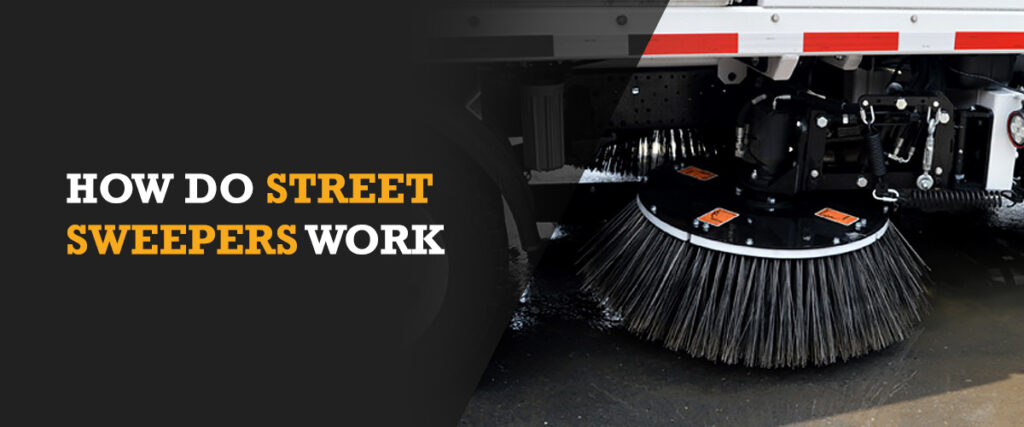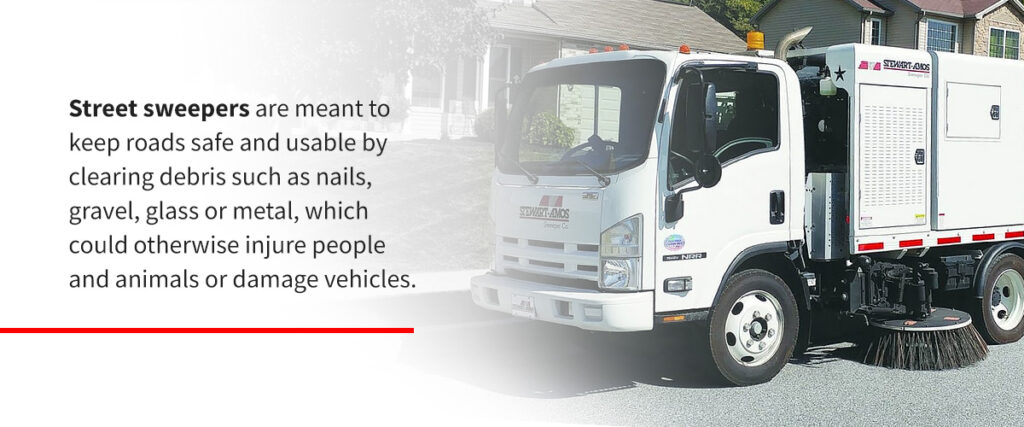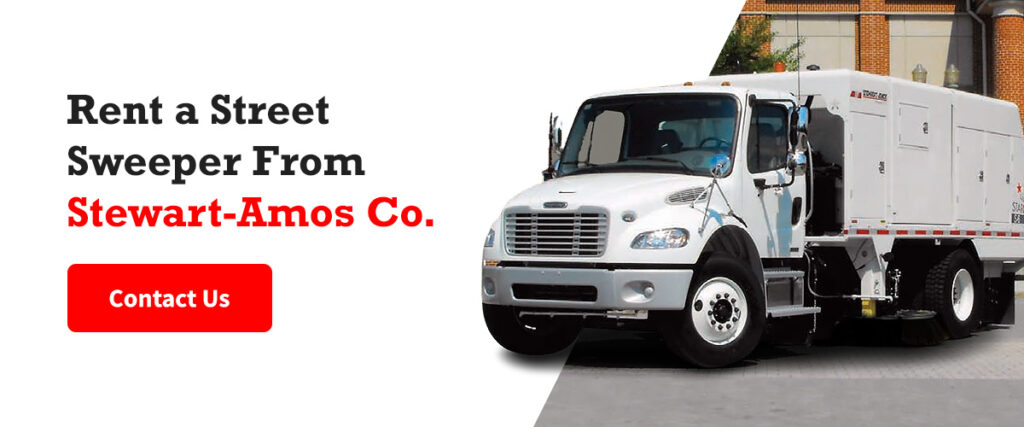
Sweepers work to keep city streets clean and usable throughout the year. Roads filled with debris or trash are cleared using vacuum sweepers or mechanical broom sweepers that gather the dirt, glass and sand into a container and allow pedestrians to use the sidewalks and drivers to use the roads without fear of an injury or accident. They are also common at construction sites to clear smaller debris created by demolition and building.
Street sweepers help make a neighborhood livable for its residents and protect the pavement and local wildlife from hazardous materials and pollutants. Using street sweepers has many health and safety benefits by maintaining and promoting cleanliness in neighborhoods, work sites and more.
What Is a Street Sweeper
A street sweeper is a machine that helps control pollutants in stormwater. Street sweeping often involves using mechanical or vacuum cleaning equipment to remove particulates from pavement or street surfaces before stormwater runoff washes potentially hazardous materials into rivers, streams, habitats and residential properties.
Vacuum sweepers are known to be effective at sweeping fine materials like clays, sands or silts, as well as coarse particles like sand and gravel debris. Street sweepers are often equipped with jets that spray pavement with pressurized water to prevent dust from spreading as the sweeping brushes remove dirt.
Street sweepers use a cylindrical brush to collect debris onto a conveyor belt and contain the dirt in a storage container. Other machines use vacuums to remove dirt and debris from the streets quickly.
What Are the Different Types of Street Sweepers?
Street sweepers have many different capabilities and usages, depending on the machine needed. Whether a city needs street sweeper trash removal or fine sand and dirt cleanup, these machines can suction debris out of cracks and crevices in pavement and roadways to ensure a clean street safe for pedestrians and drivers.
Common types include:
Mechanical Broom Sweepers
Mechanical broom sweepers have a cylindrical rotating broom at the machine’s rear. This broom flicks dirt onto a conveyor belt and sends it to a hopper for collection. These are one of the oldest types of sweepers, with early machines being horse-drawn and later motorized. Modern mechanical street sweepers effectively pick up heavy material like gravel or sand and break down larger particles.
Mechanical brooms may leave some material behind, as the machine is not as effective as other sweeper types at picking up debris within deep cracks or potholes in the pavement. Mechanical brooms are often used in the construction industry for picking up gravel and millings.
Vacuum Sweepers
These street sweepers use an engine-powered fan that creates a suction to trap dirt and debris in a hopper. A screen trap separates lighter materials like leaves from heavier materials like gravel or sand. Surface debris is removed from the pavement using brooms that move the dirt into a suctioned nozzle while loosening particles and transferring debris into a containment center.
Compared to mechanical sweepers, vacuum street sweepers are better at picking up fine materials and are often used on municipal streets to keep storm drains and roadways clear, clean out street gutters and free potholes of leaves or gravel.
Regenerative Air Sweepers
Regenerative air sweepers have an engine-powered blower that produces a powerful blast of air to cross the sweeper’s width and suck dirt and debris into a hopper. A dust separator operates simultaneously to clean the air.
Air sweepers create a closed-loop air cycle that is better for picking up small materials due to the cylindrical broom’s accessible reach. Regenerative air sweepers are often used for sweeping streets or paved parking lots.

How Do Street Sweepers Work?
Street sweepers are meant to keep roads safe and usable by clearing debris such as nails, gravel, glass or metal, which could otherwise injure people and animals or damage vehicles.
Inside most sweepers are two engines. The first engine powers the truck with diesel fuel, while the second powers the circular broom heads, water spouts and suction components that pull the dirt and debris into the hopper.
Some models have a round of spouts is located at the front of the vehicle that wets the road and debris, while others are intended for dry operation only.
The broom heads sit behind the truck’s front wheels. The driver of the street sweeper is often seated on the right side of the vehicle watching the curbside broom and overseeing safe operation. Meanwhile, rubber skirts on the truck keep debris from getting trapped underneath the vehicle.
What Is the Importance of Street Sweepers?
There are many benefits of street sweepers, including air and stormwater quality improvements and the clearance of storm drainage systems. Sweepers keep city streets clean and clear the road of leaves, trash and dirt that could be a safety hazard to cars, bicycles and pedestrians.
Health Benefits
Depending on the type of street sweeper used, the truck can remove larger dirt or finer particles from the cracks and crevices. Debris of all shapes and sizes can cause harm to people or property.
Fine dust particles could infiltrate stormwater runoff with toxins and contaminants such as lubricants, coolants, brake dust and petroleum. Sweepers that clear the road of these toxins prevent the particles from being picked up by rain runoff and entering local waterways. Removing hazardous materials keeps schools, homes and streets clean and healthy.
Safety Benefits
Street sweepers can improve safety in neighborhoods and cities by removing roadside debris that might cause vehicle accidents. Materials in the street can also be hazardous for pedestrians, runners or cyclists who want to avoid injuries or dirty sidewalks.
Clean, welcoming streets encourage residents to use their streets and sidewalks often while maintaining a clear standard of living that improves their overall safety.
Environmental Benefits
Street sweepers help preserve the environment by removing debris that could seep into groundwater or run into rivers, lakes, beaches and other bodies of water. By removing harmful pollutants, sweepers keep them out of the air, protecting local environments and preserving wildlife habitats.
It also helps preserve urban environments by extending the life of paved roads and paths around the neighborhood.
Rent a Street Sweeper From Stewart-Amos Co.
Stewart-Amos Equipment Co. is the mid-Atlantic region’s premier aggregate crushing and conveying equipment supplier. We offer expertise on each project, including design and layout, engineering or assembly and installation. Our company is dedicated to providing specialty wear item solutions for the mining and construction industries while offering rentals such as hydraulic hammers, mining pumps and street sweepers. Stewart-Amos Equipment Co. aims to serve our customers to the best of our abilities while finding them the right machinery for the best value.
Contact us online to rent a street sweeper or to learn more about your options.

